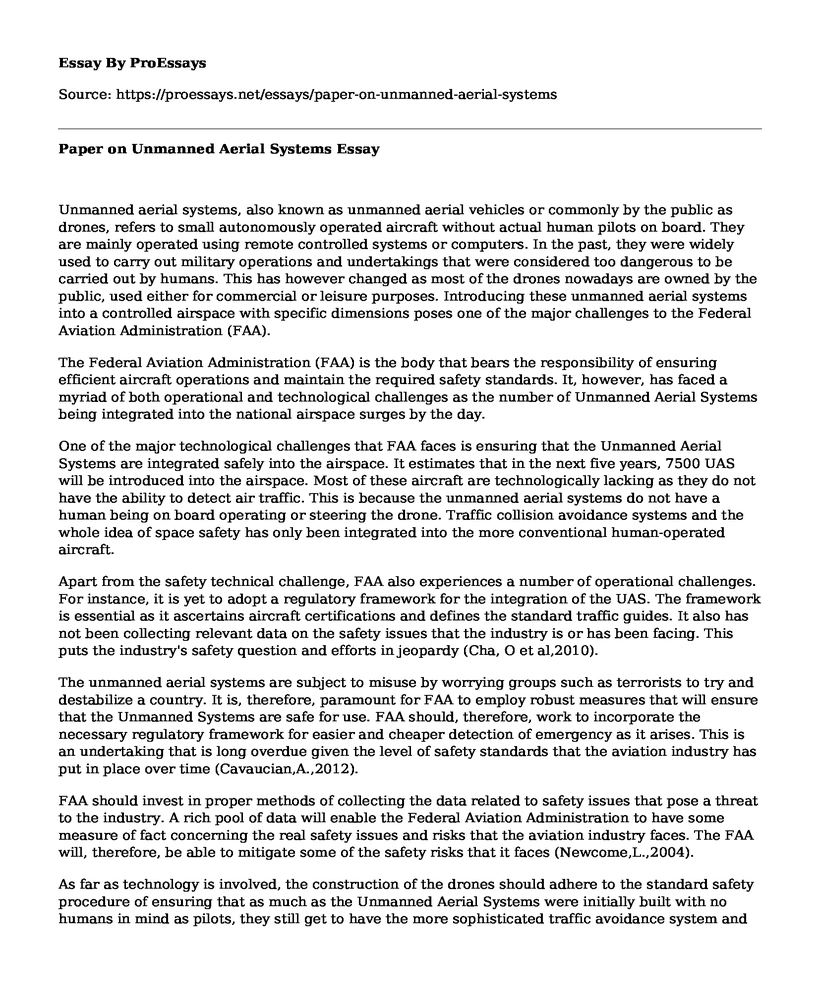Unmanned aerial systems, also known as unmanned aerial vehicles or commonly by the public as drones, refers to small autonomously operated aircraft without actual human pilots on board. They are mainly operated using remote controlled systems or computers. In the past, they were widely used to carry out military operations and undertakings that were considered too dangerous to be carried out by humans. This has however changed as most of the drones nowadays are owned by the public, used either for commercial or leisure purposes. Introducing these unmanned aerial systems into a controlled airspace with specific dimensions poses one of the major challenges to the Federal Aviation Administration (FAA).
The Federal Aviation Administration (FAA) is the body that bears the responsibility of ensuring efficient aircraft operations and maintain the required safety standards. It, however, has faced a myriad of both operational and technological challenges as the number of Unmanned Aerial Systems being integrated into the national airspace surges by the day.
One of the major technological challenges that FAA faces is ensuring that the Unmanned Aerial Systems are integrated safely into the airspace. It estimates that in the next five years, 7500 UAS will be introduced into the airspace. Most of these aircraft are technologically lacking as they do not have the ability to detect air traffic. This is because the unmanned aerial systems do not have a human being on board operating or steering the drone. Traffic collision avoidance systems and the whole idea of space safety has only been integrated into the more conventional human-operated aircraft.
Apart from the safety technical challenge, FAA also experiences a number of operational challenges. For instance, it is yet to adopt a regulatory framework for the integration of the UAS. The framework is essential as it ascertains aircraft certifications and defines the standard traffic guides. It also has not been collecting relevant data on the safety issues that the industry is or has been facing. This puts the industry's safety question and efforts in jeopardy (Cha, O et al,2010).
The unmanned aerial systems are subject to misuse by worrying groups such as terrorists to try and destabilize a country. It is, therefore, paramount for FAA to employ robust measures that will ensure that the Unmanned Systems are safe for use. FAA should, therefore, work to incorporate the necessary regulatory framework for easier and cheaper detection of emergency as it arises. This is an undertaking that is long overdue given the level of safety standards that the aviation industry has put in place over time (Cavaucian,A.,2012).
FAA should invest in proper methods of collecting the data related to safety issues that pose a threat to the industry. A rich pool of data will enable the Federal Aviation Administration to have some measure of fact concerning the real safety issues and risks that the aviation industry faces. The FAA will, therefore, be able to mitigate some of the safety risks that it faces (Newcome,L.,2004).
As far as technology is involved, the construction of the drones should adhere to the standard safety procedure of ensuring that as much as the Unmanned Aerial Systems were initially built with no humans in mind as pilots, they still get to have the more sophisticated traffic avoidance system and tools. This will result in almost zero air traffic collision.
References
Cavoukian, A. (2012). Privacy and drones: Unmanned aerial vehicles (pp. 1-30). Ontario, Canada: Information and Privacy Commissioner of Ontario, Canada.
Chao, H., Cao, Y., & Chen, Y. (2010). Autopilots for small unmanned aerial vehicles: a survey. International Journal of Control, Automation and Systems, 8(1), 36-44.
Newcome, L. R. (2004). Unmanned aviation: a brief history of unmanned aerial vehicles. Aiaa.
Cite this page
Paper on Unmanned Aerial Systems. (2021, Mar 29). Retrieved from https://proessays.net/essays/paper-on-unmanned-aerial-systems
If you are the original author of this essay and no longer wish to have it published on the ProEssays website, please click below to request its removal:
- Critical Article Analysis Essay on Vision 2030
- PEM Hydrogen Fuel Cells Research Paper Example
- Research Paper on Airlines
- 5 Deadliest Jets Fighter Aircrafts in the World Essay
- Innovative Construction Project of Saudi Aramco Paper Example
- Managing People in Aviation: Maximizing Performance for Success - Essay Sample
- MSF's Role in Global Politics: Strategies, Challenges, & Impact







